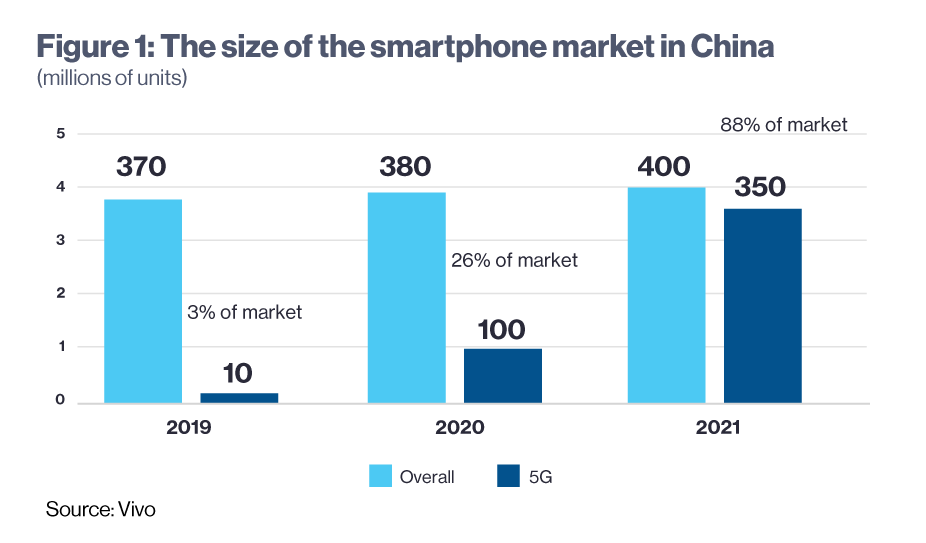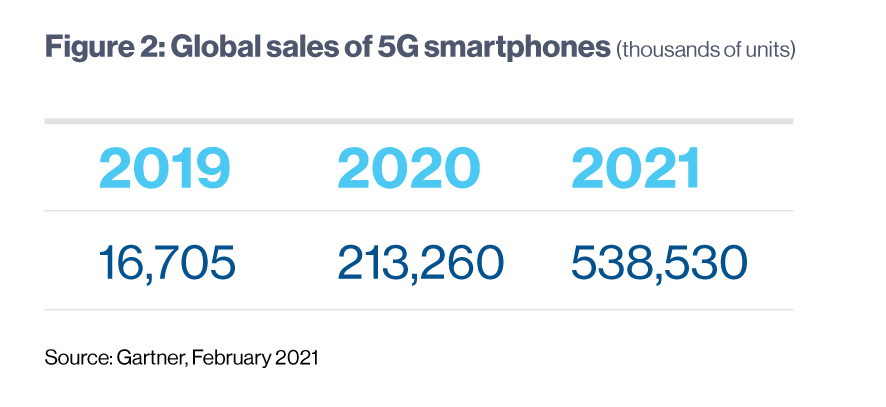Tech
How to accelerate the world into the 5G era
Published
3 years agoon
By
Terry Power
Demand for 5G smartphones is reaching an all-time high
In 2021, consumers and institutions alike are fast-tracking a digital revolution in an unprecedented era of social distancing and remote work—a trend that may continue long after the pandemic subsides.
The time is ripe for many commercialized products and services to ride the wave of unparalleled high-speed connectivity and minimal latency enabled by 5G. Yet, the technology at the forefront of them all is without a doubt the smartphone. By combining mobile telephone and computing functions within a singular multi-purpose device, smartphones have brought about a profound scale of mobility and accessibility with one-stop services that empower consumers across every aspect of their daily lives.
Some may look back fondly on the good old days of the mobile phone, when voice calls and text messaging were all we had access to, in the absence of addictive social media platforms and the seemingly endless barrage of notifications we receive nowadays. Nonetheless, the instantaneous connectivity of ever-improving mobile networks and increasingly diverse applications of smartphones will undeniably continue to bring value to users.
According to a forecast by vivo, one of the leading smartphone makers, demand for 5G devices is catching up to the entirety of the smartphone market as researchers recorded exponential growth between 2020 and 2021.
Another report, published by Gartner, showed that the worldwide demand for smartphones with 5G capabilities more than doubled this year. “In 2020, consumers reduced spending on smartphones, but the availability of new products will see users drive significant uptick in demand in 2021. Lower-end 5G smartphones, which are becoming more prevalent outside China, are poised to drive more momentum for 5G smartphones in 2021 across all regions,” said Anshul Gupta, senior research director at Gartner.

How did we get to where we are today, and how did smartphone brands take us here?
Defining the fifth generation
5G is the latest global wireless standard, otherwise known as the 5th generation of cellular mobile communication technology. Compared to 4G LTE technology, 5G increases flux density a hundredfold and connection density tenfold. This allows for a new kind of digital infrastructure that can connect virtually everything and everyone via peak data transmission speeds with minimal latency to provide a uniform experience to us all, culminating in higher efficiency and optimized performance to empower new user experiences.
Hundreds of thousands of industries are becoming integrated, owing to the reliable and streamlined network between machines, devices, and other digital objects. With many creative applications ranging from augmented reality/virtual reality experiences to vehicle-to-everything driverless cars and many more, 5G will provide humankind with the foundation to establish smart cities with comprehensive internet-of-things technologies that can efficiently restructure our lived environments and redefine our everyday lifestyles.
It goes without saying that 5G can facilitate limitless applications, on both industrial and consumer levels. For tech-savvy individuals accustomed to heavy device usage loads, 5G will be game-changing by elevating their collective digital devices into powerful, cloud-synced gateways capable of tapping into the most resource-intensive applications and data streams. Many industries are currently undergoing paradigm shifts as enterprises and countries race to propel society into the next phase of technological transformation.
Gearing up for the 5G race – a deep dive with vivo
The 5G technical standard was formed by a series of innovative R&D efforts led by companies such as vivo. The 5G products or services consumers are presented with today are actually a refined conglomeration of technologies formulated by the 3rd Generation Partnership Project (3GPP), a consortium of international telecom standards organizations that provide a stable platform for collaboration.
As the entire world becomes familiar with the limitless possibilities of contemporary mobile communications technology, consumers are looking to arm themselves with devices that contain cutting-edge capabilities in order to complement their connected and fast-paced daily lifestyles.
Corporations and governments are both racing to gear up in preparation for the new digital gold rush. Unbeknownst to many, battles are fought and alliances are formed every day as companies cannibalize each other in the race to hold the most patents for 5G technologies.
Vivo, one of the top players, has participated in the 3GPP 5G standard formulation for over five years. As one of many companies that set their sights on 5G technology, vivo established special 5G task forces back in December 2016 across Beijing and Shenzhen, China. One month later, vivo made its debut at the 2017 3GPP meeting. Since then, vivo has submitted over 5,000 5G proposals to the 3GPP, leading to 15 technical features and getting three technical projects approved. With more than 100 global standard experts staffed at its communication research institute, vivo now holds over 3,000 patents for 5G inventions.
User-oriented innovation
As a leading smartphone company with in-depth R&D capabilities, vivo is dedicated to accelerating the empowerment of consumers en masse in this new era by designing cutting-edge 5G smartphones that are available at every price point. Having amassed over 400 million users worldwide, vivo has a deep understanding of evolving consumer demands and strives to bridge users with the digital world by becoming one of the leading contributors to 5G technology in the industry.
“The main gateway for consumers to indulge in the new digital era must be the most accessible, portable, cost-effective, and readily available digital device of them all: the smartphone. A leader in both smartphone manufacturing and 5G connectivity, vivo has been designing a diverse lineup of products that are ready for the next generation of connectivity to bring joy to users worldwide at modest price points,” says Rakesh Tamrakar, 5G standards expert at vivo.
Tamrakar has 20 years of experience in the mobile communications industry. He is one of the lead delegates representing vivo in the 3GPP, holds numerous patents, and has chaired multiple 3GPP RAN1 sessions (which specify the physical layer of radio interfaces) that led to the successful standardization of MIMO, NR on unlicensed spectrum technologies. Multiple Input Multiple Output (MIMO) is a key 5G technology that increases throughput and signal-to-noise ratio, while NR is a new radio interface and radio access technology for cellular networks. He has authored and contributed numerous technical papers on the subject of 3GPP RAN1 in 3G, 4G, and 5G standards.
“Brought to life by our strong R&D network across nine innovation centers and supported by research teams across the globe, vivo knows consumers best within the industry. We focus on innovations in hardware design and the software ecosystem to improve terminal performance and user experiences. Putting end users at the center of everything we do, vivo invests heavily into 5G connectivity to reach the stage of product realization and getting this technology into the hands of consumers,” he adds.
5G research, standardization, and industrialization by vivo
Vivo’s unique user-oriented innovation is the genesis behind its numerous patented contributions to 5G standards, many of which have been universally acclaimed at the 3GPP meeting and are currently already being adapted for everyday smartphone users.
One of vivo’s most notable contributions includes the standardization and performance enhancement of Rel-17 multi-SIM technology. Previously, an incoming voice call from one competing 5G SIM card would interrupt the data flow of the other, resulting in abysmal performance as one would cancel the other. Having discovered early on that consumers had a preference for 5G smartphones with dual-SIM card slots for greater flexibility in different usage scenarios, vivo researchers successfully sought to negate the clash, leading to the existence of multi-SIM 5G smartphones on the market today.
The initial implementation of 5G technology was initially found to be quite resource-draining compared to devices running on 4G. However, consumers had grown accustomed to the substantial usage time allowed by previous smartphones.
Always innovating with the user in mind, the Rel-16 terminal power-saving technology patented by vivo manages to simplify terminal actions. It lowers normal energy consumption by creating a new “dozing” state, allowing the device software to become inactive while the hardware becomes idle. 5G smartphones can now intelligently catch every chance to take a rest, thereby prolonging battery life.
Additionally, vivo underwent algorithm and system optimization to facilitate this technology, combined with 120-watt fast charging to ensure complete user satisfaction with their devices. Select vivo smartphones are housed with a superconducting carbon fiber liquid cooling system to prevent device overheating, which is especially prevalent during intensive multimedia entertainment or e-sports usage scenarios.
Another issue raised by 5G technology is the increasing number of antennas and components installed inside a smartphone. However, users are relentless in their pursuit for ultra-thin smartphones encased in sleek metallic exteriors. Never one to disappoint, vivo’s proprietary 3D stack design uniquely encases all of this industry-leading technology to allow new 5G smartphones to be even slimmer than its 4G predecessors.
6G visionary
As 5G commercial networks are gradually deployed around the world and progressively advanced devices increasingly permeate every aspect of our livelihoods, thought leaders of the mobile industry are already looking forward to its next generation: 6G.
Vivo is part of a select few that hold the extensive expertise and in-depth understanding of consumer needs in order to turn this vision into a reality. Along with leading companies, research groups, and academic institutions, this combined elite collective is expected to reach a consensus on the ideation and requirements for this future generation of connectivity. To kickstart this exciting new era, the vivo Communications Research Institute (VCRI) released two white papers in late 2020 that break down the facets of 6G technology. Providing a diverse set of hypothetical scenarios and case studies, vivo communication standard experts have analyzed how the sixth generation will embody much more than technological transformation as it merges our physical and digital worlds.
“Currently, mobile infrastructure is still relatively isolated from the physical world, existing solely as an auxiliary tool for consumer usage. An extreme degree of seamlessness will be required to dynamically connect our physical surrounding with the omnipresent digital systems. In 2030 and beyond, 6G standard technologies will begin to foster a ubiquitous, sophisticated, real-time, and fully integrated digital world. This new realm will revolutionize thousands of industries with an extraordinary variety of applications to result in an efficient, sustainable, and eco-friendly future world,” says Tamrakar.
6G communication systems will comprise many device terminals to realize the agile perception and accurate control between digital systems with our physical domain; this is comparable to the nerve endings that perceive essential information from every inch of the human body for our central nervous system to take responsive measures. As such, a large number of harmoniously connected and intelligent terminals in the form of smartphones or wearable devices will be fundamentally required in order for the entire IoE (internet-of-everything) system to be effective. To that end, vivo has launched a smartwatch, wireless earbuds, and Jovi AI assistant to introduce users to its own flourishing digital ecosystem.
Notwithstanding all of this exhaustive groundwork laid by technology companies, the 5G race and the 6G marathon are far from over. Nonetheless, affordable smartphones with innovative features will continue to act as the interface for everyday users to engage with the all-encompassing network infrastructure, to accelerate the impending intelligent transformation of society.
This content was produced by Insights, the custom content arm of MIT Technology Review. It was not written by MIT Technology Review’s editorial staff.
You may like
-


Open finance heralds a new era
-


The Download: lab-grown chicken, and rewilding the world
-


World Sickle Cell Awareness Day: Risk Factors, Complications Of Genetic Blood Disorder
-


World Blood Donor Day: 4 Health Benefits Of Donating Blood
-


World Brain Tumor Day: Warning Signs That You Should Not Ignore
-


World Food Safety Day: Tips To Prevent Contamination

My senior spring in high school, I decided to defer my MIT enrollment by a year. I had always planned to take a gap year, but after receiving the silver tube in the mail and seeing all my college-bound friends plan out their classes and dorm decor, I got cold feet. Every time I mentioned my plans, I was met with questions like “But what about school?” and “MIT is cool with this?”
Yeah. MIT totally is. Postponing your MIT start date is as simple as clicking a checkbox.
COURTESY PHOTO
Now, having finished my first year of classes, I’m really grateful that I stuck with my decision to delay MIT, as I realized that having a full year of unstructured time is a gift. I could let my creative juices run. Pick up hobbies for fun. Do cool things like work at an AI startup and teach myself how to create latte art. My favorite part of the year, however, was backpacking across Europe. I traveled through Austria, Slovakia, Russia, Spain, France, the UK, Greece, Italy, Germany, Poland, Romania, and Hungary.
Moreover, despite my fear that I’d be losing a valuable year, traveling turned out to be the most productive thing I could have done with my time. I got to explore different cultures, meet new people from all over the world, and gain unique perspectives that I couldn’t have gotten otherwise. My travels throughout Europe allowed me to leave my comfort zone and expand my understanding of the greater human experience.
“In Iceland there’s less focus on hustle culture, and this relaxed approach to work-life balance ends up fostering creativity. This was a wild revelation to a bunch of MIT students.”
When I became a full-time student last fall, I realized that StartLabs, the premier undergraduate entrepreneurship club on campus, gives MIT undergrads a similar opportunity to expand their horizons and experience new things. I immediately signed up. At StartLabs, we host fireside chats and ideathons throughout the year. But our flagship event is our annual TechTrek over spring break. In previous years, StartLabs has gone on TechTrek trips to Germany, Switzerland, and Israel. On these fully funded trips, StartLabs members have visited and collaborated with industry leaders, incubators, startups, and academic institutions. They take these treks both to connect with the global startup sphere and to build closer relationships within the club itself.
Most important, however, the process of organizing the TechTrek is itself an expedited introduction to entrepreneurship. The trip is entirely planned by StartLabs members; we figure out travel logistics, find sponsors, and then discover ways to optimize our funding.

COURTESY PHOTO
In organizing this year’s trip to Iceland, we had to learn how to delegate roles to all the planners and how to maintain morale when making this trip a reality seemed to be an impossible task. We woke up extra early to take 6 a.m. calls with Icelandic founders and sponsors. We came up with options for different levels of sponsorship, used pattern recognition to deduce the email addresses of hundreds of potential contacts at organizations we wanted to visit, and all got scrappy with utilizing our LinkedIn connections.
And as any good entrepreneur must, we had to learn how to be lean and maximize our resources. To stretch our food budget, we planned all our incubator and company visits around lunchtime in hopes of getting fed, played human Tetris as we fit 16 people into a six-person Airbnb, and emailed grocery stores to get their nearly expired foods for a discount. We even made a deal with the local bus company to give us free tickets in exchange for a story post on our Instagram account.
Tech
The Download: spying keyboard software, and why boring AI is best
Published
9 months agoon
22 August 2023By
Terry Power
This is today’s edition of The Download, our weekday newsletter that provides a daily dose of what’s going on in the world of technology.
How ubiquitous keyboard software puts hundreds of millions of Chinese users at risk
For millions of Chinese people, the first software they download onto devices is always the same: a keyboard app. Yet few of them are aware that it may make everything they type vulnerable to spying eyes.
QWERTY keyboards are inefficient as many Chinese characters share the same latinized spelling. As a result, many switch to smart, localized keyboard apps to save time and frustration. Today, over 800 million Chinese people use third-party keyboard apps on their PCs, laptops, and mobile phones.
But a recent report by the Citizen Lab, a University of Toronto–affiliated research group, revealed that Sogou, one of the most popular Chinese keyboard apps, had a massive security loophole. Read the full story.
—Zeyi Yang
Why we should all be rooting for boring AI
Earlier this month, the US Department of Defense announced it is setting up a Generative AI Task Force, aimed at “analyzing and integrating” AI tools such as large language models across the department. It hopes they could improve intelligence and operational planning.
But those might not be the right use cases, writes our senior AI reporter Melissa Heikkila. Generative AI tools, such as language models, are glitchy and unpredictable, and they make things up. They also have massive security vulnerabilities, privacy problems, and deeply ingrained biases.
Applying these technologies in high-stakes settings could lead to deadly accidents where it’s unclear who or what should be held responsible, or even why the problem occurred. The DoD’s best bet is to apply generative AI to more mundane things like Excel, email, or word processing. Read the full story.
This story is from The Algorithm, Melissa’s weekly newsletter giving you the inside track on all things AI. Sign up to receive it in your inbox every Monday.
The ice cores that will let us look 1.5 million years into the past
To better understand the role atmospheric carbon dioxide plays in Earth’s climate cycles, scientists have long turned to ice cores drilled in Antarctica, where snow layers accumulate and compact over hundreds of thousands of years, trapping samples of ancient air in a lattice of bubbles that serve as tiny time capsules.
By analyzing those cores, scientists can connect greenhouse-gas concentrations with temperatures going back 800,000 years. Now, a new European-led initiative hopes to eventually retrieve the oldest core yet, dating back 1.5 million years. But that impressive feat is still only the first step. Once they’ve done that, they’ll have to figure out how they’re going to extract the air from the ice. Read the full story.
—Christian Elliott
This story is from the latest edition of our print magazine, set to go live tomorrow. Subscribe today for as low as $8/month to ensure you receive full access to the new Ethics issue and in-depth stories on experimental drugs, AI assisted warfare, microfinance, and more.
The must-reads
I’ve combed the internet to find you today’s most fun/important/scary/fascinating stories about technology.
1 How AI got dragged into the culture wars
Fears about ‘woke’ AI fundamentally misunderstand how it works. Yet they’re gaining traction. (The Guardian)
+ Why it’s impossible to build an unbiased AI language model. (MIT Technology Review)
2 Researchers are racing to understand a new coronavirus variant
It’s unlikely to be cause for concern, but it shows this virus still has plenty of tricks up its sleeve. (Nature)
+ Covid hasn’t entirely gone away—here’s where we stand. (MIT Technology Review)
+ Why we can’t afford to stop monitoring it. (Ars Technica)
3 How Hilary became such a monster storm
Much of it is down to unusually hot sea surface temperatures. (Wired $)
+ The era of simultaneous climate disasters is here to stay. (Axios)
+ People are donning cooling vests so they can work through the heat. (Wired $)
4 Brain privacy is set to become important
Scientists are getting better at decoding our brain data. It’s surely only a matter of time before others want a peek. (The Atlantic $)
+ How your brain data could be used against you. (MIT Technology Review)
5 How Nvidia built such a big competitive advantage in AI chips
Today it accounts for 70% of all AI chip sales—and an even greater share for training generative models. (NYT $)
+ The chips it’s selling to China are less effective due to US export controls. (Ars Technica)
+ These simple design rules could turn the chip industry on its head. (MIT Technology Review)
6 Inside the complex world of dissociative identity disorder on TikTok
Reducing stigma is great, but doctors fear people are self-diagnosing or even imitating the disorder. (The Verge)
7 What TikTok might have to give up to keep operating in the US
This shows just how hollow the authorities’ purported data-collection concerns really are. (Forbes)
8 Soldiers in Ukraine are playing World of Tanks on their phones
It’s eerily similar to the war they are themselves fighting, but they say it helps them to dissociate from the horror. (NYT $)
9 Conspiracy theorists are sharing mad ideas on what causes wildfires
But it’s all just a convoluted way to try to avoid having to tackle climate change. (Slate $)
10 Christie’s accidentally leaked the location of tons of valuable art 

Seemingly thanks to the metadata that often automatically attaches to smartphone photos. (WP $)
Quote of the day
“Is it going to take people dying for something to move forward?”
—An anonymous air traffic controller warns that staffing shortages in their industry, plus other factors, are starting to threaten passenger safety, the New York Times reports.
The big story
Inside effective altruism, where the far future counts a lot more than the present

October 2022
Since its birth in the late 2000s, effective altruism has aimed to answer the question “How can those with means have the most impact on the world in a quantifiable way?”—and supplied methods for calculating the answer.
It’s no surprise that effective altruisms’ ideas have long faced criticism for reflecting white Western saviorism, alongside an avoidance of structural problems in favor of abstract math. And as believers pour even greater amounts of money into the movement’s increasingly sci-fi ideals, such charges are only intensifying. Read the full story.
—Rebecca Ackermann
We can still have nice things
A place for comfort, fun and distraction in these weird times. (Got any ideas? Drop me a line or tweet ’em at me.)
+ Watch Andrew Scott’s electrifying reading of the 1965 commencement address ‘Choose One of Five’ by Edith Sampson.
+ Here’s how Metallica makes sure its live performances ROCK. ($)
+ Cannot deal with this utterly ludicrous wooden vehicle.
+ Learn about a weird and wonderful new instrument called a harpejji.
Tech
Why we should all be rooting for boring AI
Published
9 months agoon
22 August 2023By
Terry Power
This story originally appeared in The Algorithm, our weekly newsletter on AI. To get stories like this in your inbox first, sign up here.
I’m back from a wholesome week off picking blueberries in a forest. So this story we published last week about the messy ethics of AI in warfare is just the antidote, bringing my blood pressure right back up again.
Arthur Holland Michel does a great job looking at the complicated and nuanced ethical questions around warfare and the military’s increasing use of artificial-intelligence tools. There are myriad ways AI could fail catastrophically or be abused in conflict situations, and there don’t seem to be any real rules constraining it yet. Holland Michel’s story illustrates how little there is to hold people accountable when things go wrong.
Last year I wrote about how the war in Ukraine kick-started a new boom in business for defense AI startups. The latest hype cycle has only added to that, as companies—and now the military too—race to embed generative AI in products and services.
Earlier this month, the US Department of Defense announced it is setting up a Generative AI Task Force, aimed at “analyzing and integrating” AI tools such as large language models across the department.
The department sees tons of potential to “improve intelligence, operational planning, and administrative and business processes.”
But Holland Michel’s story highlights why the first two use cases might be a bad idea. Generative AI tools, such as language models, are glitchy and unpredictable, and they make things up. They also have massive security vulnerabilities, privacy problems, and deeply ingrained biases.
Applying these technologies in high-stakes settings could lead to deadly accidents where it’s unclear who or what should be held responsible, or even why the problem occurred. Everyone agrees that humans should make the final call, but that is made harder by technology that acts unpredictably, especially in fast-moving conflict situations.
Some worry that the people lowest on the hierarchy will pay the highest price when things go wrong: “In the event of an accident—regardless of whether the human was wrong, the computer was wrong, or they were wrong together—the person who made the ‘decision’ will absorb the blame and protect everyone else along the chain of command from the full impact of accountability,” Holland Michel writes.
The only ones who seem likely to face no consequences when AI fails in war are the companies supplying the technology.
It helps companies when the rules the US has set to govern AI in warfare are mere recommendations, not laws. That makes it really hard to hold anyone accountable. Even the AI Act, the EU’s sweeping upcoming regulation for high-risk AI systems, exempts military uses, which arguably are the highest-risk applications of them all.
While everyone is looking for exciting new uses for generative AI, I personally can’t wait for it to become boring.
Amid early signs that people are starting to lose interest in the technology, companies might find that these sorts of tools are better suited for mundane, low-risk applications than solving humanity’s biggest problems.
Applying AI in, for example, productivity software such as Excel, email, or word processing might not be the sexiest idea, but compared to warfare it’s a relatively low-stakes application, and simple enough to have the potential to actually work as advertised. It could help us do the tedious bits of our jobs faster and better.
Boring AI is unlikely to break as easily and, most important, won’t kill anyone. Hopefully, soon we’ll forget we’re interacting with AI at all. (It wasn’t that long ago when machine translation was an exciting new thing in AI. Now most people don’t even think about its role in powering Google Translate.)
That’s why I’m more confident that organizations like the DoD will find success applying generative AI in administrative and business processes.
Boring AI is not morally complex. It’s not magic. But it works.
Deeper Learning
AI isn’t great at decoding human emotions. So why are regulators targeting the tech?
Amid all the chatter about ChatGPT, artificial general intelligence, and the prospect of robots taking people’s jobs, regulators in the EU and the US have been ramping up warnings against AI and emotion recognition. Emotion recognition is the attempt to identify a person’s feelings or state of mind using AI analysis of video, facial images, or audio recordings.
But why is this a top concern? Western regulators are particularly concerned about China’s use of the technology, and its potential to enable social control. And there’s also evidence that it simply does not work properly. Tate Ryan-Mosley dissected the thorny questions around the technology in last week’s edition of The Technocrat, our weekly newsletter on tech policy.
Bits and Bytes
Meta is preparing to launch free code-generating software
A version of its new LLaMA 2 language model that is able to generate programming code will pose a stiff challenge to similar proprietary code-generating programs from rivals such as OpenAI, Microsoft, and Google. The open-source program is called Code Llama, and its launch is imminent, according to The Information. (The Information)
OpenAI is testing GPT-4 for content moderation
Using the language model to moderate online content could really help alleviate the mental toll content moderation takes on humans. OpenAI says it’s seen some promising first results, although the tech does not outperform highly trained humans. A lot of big, open questions remain, such as whether the tool can be attuned to different cultures and pick up context and nuance. (OpenAI)
Google is working on an AI assistant that offers life advice
The generative AI tools could function as a life coach, offering up ideas, planning instructions, and tutoring tips. (The New York Times)
Two tech luminaries have quit their jobs to build AI systems inspired by bees
Sakana, a new AI research lab, draws inspiration from the animal kingdom. Founded by two prominent industry researchers and former Googlers, the company plans to make multiple smaller AI models that work together, the idea being that a “swarm” of programs could be as powerful as a single large AI model. (Bloomberg)
